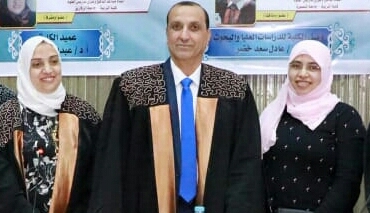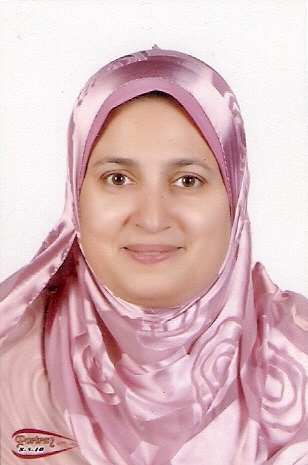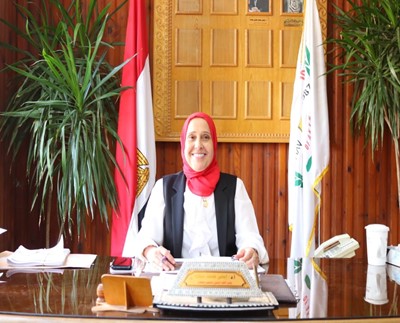
|
The Role of Social Institutions in the face of Climate Change
|
|
|
Prof. Dr. Randa Moustafa El-Deeb
|
|
|
Faculty of Education - Tanta University
|
|
|
randa.eldeeb@edu.tanta.edu.eg
|
|
|
1441
|
|
|
Summary
The issue of protecting the environment and confronting climate changes has become one of the topics that have received great attention in recent times because of their direct or indirect impact on various aspects of life, for this dear educator, you are the first responsible for preparing and building the rising generation that possesses habits, behaviors and human values in dealing with the environment And making positive decisions in addressing sensitive environmental issues as a result of their environmental awareness and awareness that was instilled in them since their early childhood.
In order to achieve the desired goal of restoring, caring for, protecting the environment and facing climate changes, it is important to go to children and educate them starting with the family and educate them in order to interact with the kindergarten and school by providing rational behavior with the environment represented in the activities organized by the kindergarten and school, and integrating the child in the activities of the classroom environment or festivals and competitions within Kindergarten and school or a non-classroom environment, such as camping outside the kindergarten and school, can develop in the child a spirit of challenge and speed of reception, as he is greatly affected by activities and practices with his peers in kindergarten and school. Therefore, everyone must have an active role in preserving the environment and facing climate change.
Based on that, the current working paper will present an explanation of the role of some social institutions represented in the family, kindergarten and school, and the mechanisms of integration between them to face climate changes.
|
|

|
برنامج مقترح فى التغيرات الجيوفيزيائية المناخية ( الكيمتريل )لتنمية الوعى بالقضايا المناخية لطلاب كلية التربية
|
|
|
أد./ فوزى أحمد الحبشى.أ.د./ نهلة عبد المعطى الصادق. د/آية محمد محمد سالم
|
|
|
التغيرات المناخية
|
|
|
aya.salem2017@yahoo.com
|
|
|
1466
|
|
|
هدف البحث الحالى إلى التعرف على أثر برنامج مقترح فى التغيرات الجيوفيزيائية المناخية ( الكيمتريل) لتنمية الوعى بالقضايا المناخية لطلاب كلية التربية، ولمعرفة أثر المتغير المستقل ( برنامج مقترح فى التغيرات الجيوفيزيائية المناخية (الكيمتريل ) على المتغير التابع ( الوعى بالقضايا المناخية) طبقت أداه البحث ( مقياس الوعى بالقضايا المناخية) على عينة من طلبة كلية التربية الفرقة الثالثة شعبتى الفيزياء والكيمياء جامعة الزقازيق ، وقد تبين من نتائج البحث وجود فروق ذات دلالة إحصائية بين متوسطات درجات طلاب مجموعة البحث فى التطبيقين القبلى والبعدى لمقياس الوعى بالقضايا المناخية ككل ولكل مستوى على حدة لصالح التطبيق البعدى، وقد تم تقديم مجموعة من التوصيات والمقترحات.
الكلمات المفتاحية: برنامج مقترح ، التغيرات الجيوفيزيائية المناخية ، الكيمتريل، الوعى بالقضايا المناخية.
ASuggested Program in Geophysics Climate Changes( Chemtrail ) to develop Concepts and Climate Issues Awareness of Faculty of Education Students
Abstract:
The current research aimed at investigating the effect of A ASuggested Program in Geophysics Climate Changes( Chemtrail ) to develop Concepts and Climate Issues Awareness of Faculty of Education Students and the research tool ( measuring Climate Issues Awareness) applied on a sample of students from the Faculty of Education, Third year of the General Education section Physics, Chemistry Zagazig University, Results indicated that There are statistically significant differences between the mean scores of the research group students in the pre and post applications of the scale of climate awareness as a whole And for each level separately in favor of the post application, some recommendations and suggestions for further research were also provided.
Key Words: A Suggested Programe , Geophysics Climate Changes, Chemtrail , Climate Issues Awareness.
|
|

|
Water -Related Adaptations to Climate Change: Harvesting of Rainfall and Flash Flood in the Eastern Desert of Egypt for the optimal sustainable development planning
|
|
|
Elsayed M. Abu El Ella
|
|
|
Assiut University
|
|
|
abuelellaem@gmail.com
|
|
|
1496
|
|
|
Egypt is one of the most vulnerable regions in the world to climate change risks. The agricultural sector is one of the affected sectors; this sector is very critical for Egypt’s national and food security since it shapes 17% of its GDP, 40% of its labor force, and 60% of its food production. Therefore, this proposal, also, focuses on the climate change impact on food security with a focus on the agricultural sector and the food production system in Egypt. And, it examines how consistently policies can manage to reduce climate change effects on Egypt’s food security through qualitative research conducted through in depth interviews with experts in the field.
This research describes a program deal with the evaluation and management of water resource systems in the Eastern Desert (Fig. 1). The research will assist in evaluating Eastern Desert surface water resources and planning the optimal development and allocation of water supplies to promote sustainable development. Bedouin\ and natives as main end users will be a major target of the project’s objectives. The project objectives will assist in poverty alleviation, accelerating agricultural development, improved agricultural and food production, combating desertification, unemployment problems and raising the individual income.
One of the major targets of the present research is to construct a complete digital GIS and watershed modelling that comprise the present and historical data about water points, present groundwater and available water supplies, abstraction levels, water consumption needs, water quality, land use pattern, soils infiltration capability, water/land use planning etc. Subsequently, surface runoff water harvesting planning and techniques will be presented and discussed, together with a proposal for new non-traditional sources of water
|
|

|
Climate changes: causes, consequences, and solutions
|
|
|
Sohila A. Khedr, Hager S. Ali
|
|
|
Sohila A.Khedr Biotechnology student at Faculty of Science, Tanta University. Hager S.Ali Microbiology student at Faculty of science ,Tanta University.
|
|
|
sohila30975080@science.tanta.edu.eg
|
|
|
1520
|
|
|
Climate change is one of the most serious and widespread environmental issues. Climate change is a hot topic for scientific debates these days due to its far-reaching effects and consequences, which are caused by both natural (climate variability, volcanic eruptions, changes in Earth's orbits, and changes in ocean circulation) and anthropogenic (industrial and energy production emissions, greenhouse gases from vehicles and agriculture). It has a negative impact on ecosystems, ranging from rising sea levels to shifting agro-ecological zones. It also has a detrimental impact on agricultural productivity, microbial diversity, soil organic matter, droughts, agro-ecological zone shifts, crop yield loss, and even major calamities such as food security issues. Climate change has wreaked the most devastation on local agricultural communities, threatening jobs, revenue sources, and agricultural goods. More than half of the local impoverished populations rely on this industry for a living, making them more vulnerable to climate change. This is a mainly critical issue in developed and poor countries. Adaptation to climate change refers to changes in socioeconomic and ecological systems in response to actual or anticipated climatic impacts and stimuli. The system's adaptive characteristics and behaviors can improve its capacity to deal with external pressures. Adaptation is the process of adapting to a shock caused by man or the environment. This reaction can occur before, during, or after the occurrence and can help sustain or develop socioecological systems. This review addresses climate change in its entirety, investigates the implications of climate change to discover solutions for adaptation of local and agricultural communities to this phenomenon, and incorporates climate change adaptation options.
|
|

|
التغيرات المناخية العالمية
|
|
|
ا د ابراهيم علي غانم
|
|
|
استاذ الجغرافيا كلية الآداب جامعة طنطا
|
|
|
ibrahim.ghanem1@art.tanta.edu.eg
|
|
|
1563
|
|
|
ماهية التغيرات المناخية
اسباب التغيرات المناخية
الأدلة علي التغيرات المناخية
دور الأمم المتحدة في قضية التغيرات المناخية
دور الولايات المتحدة الأمريكية في قضية التغيرات المناخية
دور القوي الدولية الكبري في قضية التغيرات المناخية
راي بعض العلماء المتخصصين في قضية التغيرات المناخية
حقيقة التغيرات المناخية العالمية
نتائج التغيرات المناخية علي العالم
ماهية التغيرات المناخية
اسباب التغيرات المناخية
الأدلة علي التغيرات المناخية
دور الأمم المتحدة في قضية التغيرات المناخية
دور الولايات المتحدة الأمريكية في قضية التغيرات المناخية
دور القوي الدولية الكبري في قضية التغيرات المناخية
راي بعض العلماء المتخصصين في قضية التغيرات المناخية
حقيقة التغيرات المناخية العالمية
نتائج التغيرات المناخية علي العالم
ماهية التغيرات المناخية
اسباب التغيرات المناخية
الأدلة علي التغيرات المناخية
دور الأمم المتحدة في قضية التغيرات المناخية
دور الولايات المتحدة الأمريكية في قضية التغيرات المناخية
دور القوي الدولية الكبري في قضية التغيرات المناخية
راي بعض العلماء المتخصصين في قضية التغيرات المناخية
حقيقة التغيرات المناخية العالمية
نتائج التغيرات المناخية علي العالم
ماهية التغيرات المناخية
اسباب التغيرات المناخية
الأدلة علي التغيرات المناخية
دور الأمم المتحدة في قضية التغيرات المناخية
دور الولايات المتحدة الأمريكية في قضية التغيرات المناخية
دور القوي الدولية الكبري في قضية التغيرات المناخية
راي بعض العلماء المتخصصين في قضية التغيرات المناخية
حقيقة التغيرات المناخية العالمية
نتائج التغيرات المناخية علي العالم
|
|

|
Ocean acidification induced changes in Ulva fasciata biochemistry may improve Dicentrarchus labrax aquaculture via enhanced antimicrobial activity
|
|
|
Heba S. El-Sayed1, Mostafa E. Elshobary2, Khouloud M. Barakat1, Hanan M. Khairy1, Mohamed A. El-Sheikh3, Raymond Czaja4, Bassem Allam4, Hoda H. Senousy5
|
|
|
1National Institute of Oceanography and Fisheries (NOIF), Egypt. 2Botany Department, Faculty of Science, Tanta University, 31527, Tanta, Egypt. 3Botany & Microbiology Department, College of Science, King Saud University, Riyadh, Saudi Arabia 4 School of Marine and Atmospheric Sciences, Stony Brook University, Stony Brook NY 11794 United States 5Botany & Microbiology Department, Faculty of Science, Cairo University, Giza 12613, Egypt
|
|
|
hanan_khairy@yahoo.com
|
|
|
1571
|
|
|
ABSTRACT: Changes in seawater carbonate chemistry including increased seawater carbon dioxide concentrations (pCO2), commonly known as ocean acidification (OA), can impact metabolic activities and phytochemical production in marine algae. While OA impacts typically reduce animal health, this study investigated the potential of OA-induced changes in methanol bioactivity from the macroalgae Ulva fasciata, to enhance larval European seabass (Dicentrarchus labrax) aquaculture via increasing antimicrobial activity. After exposing U. fasciata to four pCO2 levels ~ 280, 550, 750 and 1050 µatm, macroalgae methanol extracts at pCO2-750 exhibited the highest total phenolic content (TPC), flavonoid content (TFC) and yielded the highest antioxidant and antimicrobial activities. After using extracts as a daily water additive for seabass larvae, U. fasciata methanolic extract at pCO2-750 yielded the greatest reduction in pathogenic bacterial community and the highest survival rate for seabass larvae. Seabass larvae growth was also highest after exposure to methanolic extract of U. fasciata grown at pCO2-750, potentially due to higher TPC, TFC and polyunsaturated fatty acid levels. Such nutritional benefits may have been acquired by seabass larvae via direct uptake or via indirect transfer, by which live feed (Brachionus or Artemia) consumed by larvae accumulated more nutrients. Our results suggest that pCO2-750 has a significant physiological impact on U. fasciata, potentially allowing macroalgae under OA conditions to function as nutritional supplements to increase the performance of seabass aquaculture.
|
|

|
تغير كمية الأمطار في دول منابع نهر النيل خلال الفترة 1901/2016
|
|
|
أ.د. إيملي حمادة
|
|
|
أستاذ المناخ التطبيقي / البيئة كلية الآداب – جامعة المنوفية
|
|
|
emilyhelmy@gmail.com
|
|
|
1662
|
|
|
يمتد حوض النيل في أرض واسعة الأطراف ما بين المنبع والمصب في حوالي 35 درجة عرضية، ويشغل حوض النيل الجزء الأكبر من شمال شرق قارة أفريقيا، وهو بذلك يبعد عن المؤثرات البحرية المحيطية إلا في أجزائه الجنوبية حيث تلتقي أمطار المحيطين الهندي والأطلنطي في الجنوب. ويضم 11 دولة منها دول المنابع وهي بوروندي ورواندا وتنزانيا وكينيا وجمهورية الكونغو الديمقراطية وأوغندا " منابع استوائية من بحيرة فيكتوريا" بالإضافة إلى منابعه من هضبة الحبشة الشرقية في إثيوبيا وإريتريا، ودول المصب وهي جنوب السودان والسودان ومصر.
وتهدف هذه الورقة البحثية إلى رصد مقدار الزيادة والنقصان في كميات المطر في دول منابع حوض النيل (بوروندي - رواندا - تنزانيا - كينيا - جمهورية الكونغو الديمقراطية - أوغندا – إريتريا - إثيوبيا)، ومن ثم تحديد الاتجاه العام للتغير في كميات المطر خلال القرن العشرين وأوائل القرن الحادي والعشرين ( 1901 / 2016 ). وقد اعتمدت الدراسة على سجلات لكميات المطر في الدول الثمان بصفةٍ عامة دون تحديد لمحطات الرصد، وهكذا، فإن بيانات المطر المتاحة هي بيانات لكميات المطر الشهرية خلال سنوات الدراسة. وقد استندت على بيانات مواقع الشبكة الدولية المعنية برصد العناصر المناخية والظواهر الجوية.
ويتناول البحث التغيرات في كمية المطر في دول منابع النيل على عدة محاور:
|
|

|
Spatio-temporal patterns and trends of the air pollution over Egypt (2013-2021) integrating MERRA-2 and in-situ air quality data
|
|
|
Alaa A. Masoud
|
|
|
Remote Sensing Laboratory, Geology Department, Faculty of Science, Tanta University, Tanta 31527, Egypt
|
|
|
alaa_masoud@science.tanta.edu.eg
|
|
|
1675
|
|
|
Identifying significant trends in spatio-temporal air quality patterns of common air pollutants is critical for best-informed decision-making to advance climate change adaptation and alleviating current and future air pollution health risks. This study examined the patterns and trends of SO2, NO2, CO, O3, and Particulate Matter (PM) at varying micron sizes (PM1, PM2.5, and PM10) pollutants from 91 stations over Egypt during ninety-three months in the August (2013)-April (2021) period. In-situ data of the SO2, NO2, and PM10 is used to validate the counterpart satellite reanalysis MERRA-2 data. Spatial patterns are analyzed and characterized monthly, seasonally, and annually for the in-situ data. Seasonal Mann-Kendall (SMK) trend test is appraised to identify and characterize the significant monotonic trends and estimate their Sen’s slope magnitudes and hence the annual rate of change at the monitoring sites of both data.
Results of regression analysis of MERRA-2 against the in-situ SO2 and PM10 contents clarified under-estimation at RMSE of 13.38 μg m-3 and 69.46 μg m-3, respectively. Patterns of in-situ pollutants clarified local plumes at varying magnitudes characterizing different areas which frequently exceeded the Egyptian and WHO guidelines. The in-situ air pollutants exhibited significant regional decrease in the annual average in 2020 relative to the preceding years associated with the COVID-19 lockdown. Also, sustaining, either deteriorating or improving trends of the in-situ air pollutants proved annual rates which are stronger and much more significant than that detected for MERRA-2 data. In-situ data clarified SO2, NO2, and PM10 increasing trends over the Suez Canal Economic Zone (SCZone). MERRA-2 data showed SO2 and CO deteriorating trends over SCZone and the Upper Egypt industrial zones, as well as over north of the Nile Delta. Tropospheric Ozone deteriorated over the middle Nile Delta region. Particulate matters clarified north to south gradual deterioration with most contribution from deserts.
|
|

|
EWS in Climate Change
|
|
|
Dr. Mohamed Abdel wahid
|
|
|
Ministry of Health and Population
|
|
|
Mohamedalshoaibi89@gmail.com
|
|
|
1688
|
|
|
EWS in the subject field aims to minimize devastating impact of coastal hazards, especially from storms, cyclone, tsunamis and tsunami related earthquake, effective disaster risk reduction. Disaster risk knowledge including detection, monitoring, and analysis and forecasting of hazards and possible consequences are key system objectives for meteorological authority. KRIs include Green House Gases, The Global annual Mean temperature, Ocean Heat Record, Ocean Acidification, Global Mean Sea Level, The Ozone Hole over the Antarctic. As part of the high quality global data management framework for climate (HQGDMFC), the international expert group on climate data modernization (IEG-CDM), with experts from various disciplines, developed an approach for reviewing and cataloguing trusted datasets for informing on key climate indicators. The climate system must maintain equilibrium while also trying to adapt to new changes and stresses. In both of these cases, the system tends to respond gradually to changes, until the system passes in threshold, after which abrupt changes occur. Actions which can be accomplished are serve societal needs, close the capacity gap on weather, climate, hydrological and related environmental services, advance targeted research, strategic realignment and enhance earth system observations and predictions.
|
|

|
Liquefaction Failure of Storage Earth Dams under Earthquakes
|
|
|
M.S. Kirra, B. A. Zeidan, Ahmed M. Nasr, Y. B. M. Heza
|
|
|
Faculty of Engineering, Tanta University, Egypt,
|
|
|
eng_kiraa@yahoo.com
|
|
|
1701
|
|
|
Storage earth dams are mega structures that breach during earthquakes causing serious consequences from direct loss of life to indirect economic losses. The seismic vulnerability of earth dams and the potential consequences of their failures depend on their seismic response. Seismic responses appear in slope failure, piping, and displacement/settlement resulting from weak soil and/or liquefaction of loose sands. Earth dams’ failure may occur due to different reasons such as structural instability conditions, hydraulic conditions, seepage through the dam body and liquefaction failure due to earthquakes. The determination of factor of safety for the stability of dam slopes, under seismic loads, is vital to ascertain the dam overall safety. In this work, Finite Element modeling is employed for simulating slope stability and stress analysis of earth dam problems via GeoStudio software. The dam numerical model is calibrated and2-D numerical model is employed to analyze stability of five selected cases of study; three selected cases of operating loads are considered for of liquefaction area alignment. Obtained results in this paper ascertain the importance of considered factor of safety before and after earthquake excitations on liquefaction area determination. Conclusions diagnose that the min. liquefaction zone area causing liquefaction failure is about 32.96%. A safe design criteria of storage earth dams under the influence of seismic loads is developed.
Keywords: Earth dams, Seismic Load, Liquefaction Failure, Stability of slopes, GeoStudio, Factor of safety.
|
|

|
Behavior of Earth Dams under Earthquake Induced Liquefaction Failure Saddle Earth Dam, Ethiopian: A Case Study
|
|
|
*M.S. Kirra, **B. A. Zeidan, ***Ahmed M. Nasr, ****Y. B. M. Heza
|
|
|
*PhD Student, Faculty of Engineering, Tanta University, Egypt, **Prof. of Water Resources Eng. Faculty of Engineering, Tanta University, Egypt, *** Prof. of Geotechnical Eng. Faculty of Engineering, Tanta University, Egypt ****Prof. of Geotechnical Eng. Construction Research Institute, National Water Research center, Egypt
|
|
|
eng_kiraa@yahoo.com
|
|
|
1732
|
|
|
Storage earth dams are mega structures that breach during earthquakes causing serious consequences from direct loss of life to indirect economic losses. The seismic vulnerability of earth dams and the potential consequences of their failures depend on their seismic response. Seismic responses appear in slope failure, piping, and displacement/settlement resulting from weak soil and/or liquefaction of loose sands. Earth dams’ failure may occur due to different reasons such as structural instability conditions, hydraulic conditions, seepage through the dam body and liquefaction failure due to earthquakes. The determination of factor of safety for the stability of dam slopes, under seismic loads, is vital to ascertain the dam overall safety. In this work, Finite Element modeling is employed for simulating slope stability and stress analysis of earth dam problems via GeoStudio software. The dam numerical model is calibrated and 2-D numerical model is employed to analyze stability of saddle earth dam, Ethiopian cases of study; three selected cases of operating loads are considered for of liquefaction area alignment. Obtained results in this paper ascertain the importance of considered factor of safety before and after earthquake excitations on liquefaction area determination. Conclusions diagnose that the min. liquefaction zone area causing liquefaction failure is about 51.05%. Critical Scenario of failure under seismic load for saddle dam is occur cracks in concrete upstream slab, because the biggest liquefied area in this scenario.
|
|

|
Implications of Future Challenges on the sustainability of cultivation development in Toshka area, Egypt
|
|
|
Marwa M. Aly, Essam A. Kalifa, Shymaa A. K. Fayad
|
|
|
Faculty of Engineering Matareya, Helwan University, Cairo, Egypt,National Water Research Center, Egypt, International Academy for Science (IAEMS), 6th of October City, Egypt
|
|
|
shymaa2014@yahoo.com
|
|
|
1738
|
|
|
Egypt has initiated a development project to meet the increasing food demands. Toshka area is one of the selected plots where new cultivation areas were established. These reclamation areas are mainly depending on groundwater from Nubian Sandstone Aquifer. This aquifer is considered renewable where Lake Nasser recharge it by large amount of water. However, the sustainability of the project must be assessed considering impact of future challenges which are threating the Lake Nasser’s capacity. In this study, a numerical groundwater flow model (MODFLOW) has been used to perform the sensitivity analysis of the aquifer in Toshka area to recharge alteration. The model was calibrated under steady state and transient conditions. Sensitivity analysis was then performed for hydraulic conductivities, storage coefficient, and boundary condition of Lake Nasser. Different development pathways combined pumping scenarios with predicted reduction in the Lake head were simulated. The results showed the model is more sensitive to the hydraulic conductivity values in compare of storage coefficient. Moreover, the aquifer storage is highly proportional to the lake head. The aquifer will not be able to supply the required discharges if the reduction in the Lake head exceeds 20 m. The findings of this study confirmed the need to consider climate change and Ethiopian Dam implication for the long-term sustainable management of new rural development project.
|
|
|